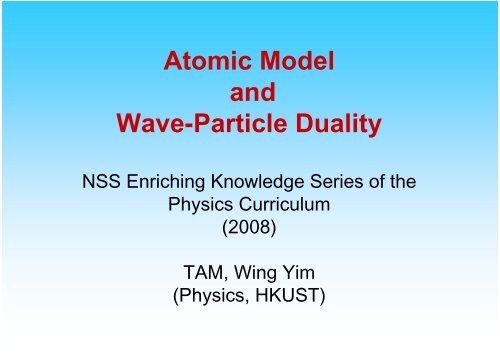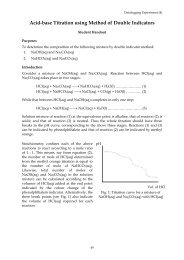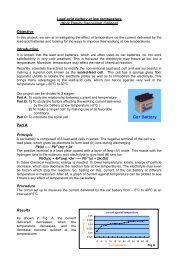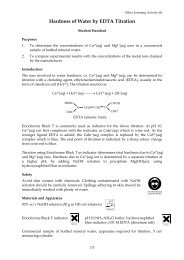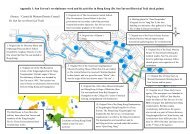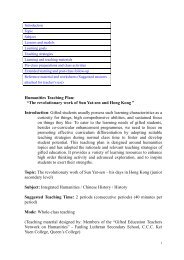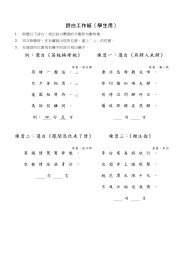Atomic Model and Wave-Particle Duality
Atomic Model and Wave-Particle Duality
Atomic Model and Wave-Particle Duality
Create successful ePaper yourself
Turn your PDF publications into a flip-book with our unique Google optimized e-Paper software.
<strong>Atomic</strong> <strong>Model</strong><strong>and</strong><strong>Wave</strong>-<strong>Particle</strong> <strong>Duality</strong>NSS Enriching Knowledge Series of thePhysics Curriculum(2008)TAM, Wing Yim(Physics, HKUST)
<strong>Atomic</strong> Theories (400 BC – 1900 AD) Democritus of Abdera (460-370 B.C.)- Basic substances: Elements- His universe consisted of empty space <strong>and</strong>an infinite number of atoms (a-tomos, the"uncuttable").- These atoms were eternal <strong>and</strong> indivisible,<strong>and</strong> moved in the void of space.- There were no experimental data.- ~ 90 elements were discovered by 1900.Democritus of Abdera John Dalton (1808)- Law of Definite Proportions:(3g of X) + (4g of Y) produces 7g of XYJohn DaltonDalton suggested – but did not prove - the ‘atomic’ natureof matter.2
Mysterious Rays using Crookes Tubes Crookes tubes are simply evacuated glasstubes with electrodes to which a voltage can beapplied. Sir William Crookes saw (in 1879) emissionfrom the cathode of such a tube <strong>and</strong> showedthat this emission could be blocked by an object. He named this ‘cathode ray’ <strong>and</strong> believed thatthese were a stream of particles of some sort.(1832-1919)cathodeanodeCrookesFlowerTube3
J.J. Thomson <strong>and</strong> the electron (1897) First: Magnetic field was used to bend the‘cathode ray’ into the electrometer (whichdetected the charge.) This showed that thecharge could not be separated from the ‘ray’. Second: He showed that the ray could bedeflected by electric field – but only after thetube had been very well evacuated by pumps.He finally combined the E <strong>and</strong> B fields from whichthe charge to mass ratio can be deduced.4
Thomson’s Conclusions1. Cathode rays are charged particles (which he called"corpuscles“, <strong>and</strong> we now call electrons).2. These electrons are constituents of the atom. He trieddifferent gases in the tube <strong>and</strong> different cathode materials,but obtained the same e/m ratio: there is only one kind ofelectron in all atoms3. The e/m ratio for ions have been known (from electrolysis)<strong>and</strong> this electron e/m is 2000 times more than that forhydrogen ions, <strong>and</strong> Thomson reasoned (correctly) that thismust mean that the electron has small mass.• He got the Nobel Prize in Physics 1906.• He also proposed the ‘Plum Pudding’ or ‘raisincake’ atomic model. (Electrons are the raisin inthe positively charge cake). More on that later.Thomson 1934http://www.aip.org/history/electron/jjsound.mp3 5
Millikan Oil Drop Experiment (1909) J.J. Thomson had determined the e/m ratio – which does notdepend on materials used. But this did not prove theexistence of the electron: There could be a range of differentsizes of electrons <strong>and</strong> still have the same e/m ratio. To determine the charge, they experimented with measuringthe motion of water droplets ‘charged’ or ionized by X-rays inan electric field – but unable to get good results due todifficulties such as evaporation of the droplets. Robert Millikan’s experiment overcame many of thosedifficulties. The key advance was the use of oil instead ofwater - the idea occurred to him on a train trip realizing thatlubrication oil does not evaporate very fast. Millikan was then able to watch the motion of single oildroplets for hours, putting on <strong>and</strong> taking away charges by X-rays, <strong>and</strong> measured the change in the velocity.6
Robert MillikanMillikan's oil drop experiment7
Millikan’s 1911 paperElectric charge is quantized!8
Thomson <strong>and</strong> Millikan:electrons have definite charge <strong>and</strong> massAtoms contain negatively charged electrons.Electrons have mass about 2000 times less thanhydrogen atom, but the (negative) electron chargeis equal to the (positive) charge of the ion inmagnitude.Atoms are neutral: there must be positive chargein them. How is the positive charge distributedwithin the atom? And what about the distributionof the mass?9
Thomson’s ‘Plum Pudding’ or‘Raisin Cake’ <strong>Model</strong> of the atom Raisins are the electrons.Positive charge <strong>and</strong> massdistributed uniformly about theatom (‘the bread’) <strong>and</strong> the sizeof the ‘bread’ is about 10 -10 m(atomic size).Rutherford asked his student to use particles fromradium as projectiles to probe this ‘raisin cake’.The sample used was a gold foil (which can be verythin).10
Rutherford’s expectation <strong>and</strong> the surprise!RadiumGold foil* The positively charged α particles have 7.7 MeV ofenergy, <strong>and</strong> 8000 times more massive than the electrons(‘the raisins’) – they will not be deflected by the electronsor the uniform positive background.* Surprise! Surprise! They found a small number of those7.7 MeV a particles deflected by very large angles –even 180 degrees!11
Scattering of α <strong>Particle</strong>s by MatterGeiger <strong>and</strong>Marsden's apparatus“It was quite the most incredible event that ever happened tome in my life. It was as incredible as if you fired a 15-inchshell at a piece of tissue paper <strong>and</strong> it came back <strong>and</strong> hityou.” Rutherford12
The Scattering of α <strong>and</strong> β <strong>Particle</strong>s by Matter <strong>and</strong> theStructure of the AtomE. Rutherford, F.R.S.*Philosophical Magazine (1911)* Rutherford realized that such large deflection could notpossibly be resulted from a single scattering in theThomson’s model.* However, he was able to show that the probability of multiplescatterings was far too small to explain the observations.* Since electric field is proportional to 1/r 2 , such high fieldrequires concentration of charge to a very small r.* The positive charge CANNOT be the ‘bread’ surroundingthe electrons – all the charge must be concentrated to avery small NUCLEUS. How small?Cambridge Physics - Discovery of the NucleusA Rutherford scattering applet13
Structure of Nucleon• In Rutherford’s scattering experiment, he keptseeing that the atomic number Z (number of protonsin the nucleus, equivalent to the positive charge ofthe atom) was less than the atomic mass A (averagemass of the atom) implying something besides theprotons in the nucleus were adding to the mass.• He put out the idea that there could be a particlewith mass but no charge. He called it a neutron.RutherfordChadwick• Rutherford’s former student James Chadwick,using a new refined particle detection, wasable to determine that the neutron did exist<strong>and</strong> that its mass was about 0.1 percent morethan the proton's. In 1935 he received theNobel Prize for his discovery.14
SummaryAtoms: Electrons + Nucleus (Protons + Neutrons)<strong>Atomic</strong> Radius ~ 10 -10 mNucleus ~ < 30 fmHydrogen Atom 1.6 x 10 -27 kg or 940 MeV/c 2Electrons:Charge -1.6 x 10 -19 C#e#p#nZA1HMass 9.1 x10 -31 kg or 0.5 MeV/c 2 238Hydrogen11011238UUranium92921469215
Everyone can seethe connectionbetween heat <strong>and</strong>light!Matter, Energy, Heat <strong>and</strong> Light We long know matter, energy, heat <strong>and</strong> lightare closely related. Need fuel (wood or coal) to keep a fireburning, giving out heat, <strong>and</strong> keep a trainrunning. When there is heat, there is light (do notthink of light as the visible part only!)– <strong>and</strong> you can tell the temperature by thecolour of the light.16
Electromagnetic RadiationLight is an electromagnetic radiation, which includesalso gamma rays, X-rays down to microwaves <strong>and</strong>radio waves.Each kind of wave has its own frequency <strong>and</strong>wavelength.Visible light has wavelengths between 400 nm <strong>and</strong>700 nm, where nm (nanometer) is 1 nm =10 -9 m.17
Maxwell Equations for Electromagnetic Radiation∇ ⋅ D∇ ⋅ B= 4πρ= 0∇×H∇×∂D∂ρ+ ∇ ⋅ J = 0∂tIn empty space, Maxwell equations have a wave solution of=E4πc+1cj+∂BThe Maxwell equations require additional equation ofcontinuity for charge density <strong>and</strong> current density.∇2vE−1c2v2∂ E2∂t=0∂t1c=∂t0E ~ sine or cosine functions18
EM <strong>Wave</strong>s: PowerAverage over one period, we haveT1< P >= ∫TP(t)dt=021μ c0E20A( =1/2)Notice that ~ E 02Intensity of the wave ~ energy carried by thewave per unit area per unit time ~ square ofthe wave amplitudei.e. I ~ E 0219
Interference of <strong>Wave</strong>s(Young’s Double Slit Experiment)1 2x 1x 2Maximum (constructive interference, in phase)when |x 1 -x 2 | = nλ.Minimum (destructive interference), out of phasewhen |x 1 -x 2 | = (n+1/2)λ.For screen distance (L) >> slits separation (d), we have|x 1 -x 2 |~ d sin θ = nλ for constructive interference. (tan θ = x/L)20
Superposition of EM <strong>Wave</strong>sEM waves obey the principle of superposition.Two (light) wave trains add up <strong>and</strong> become a new wave.However the principle of superposition does not apply toparticles or solid objects. For example, adding twoelectrons does not give you a new electron.<strong>Wave</strong>s <strong>and</strong> particles are fundamentally different!Classical picture only!!!21
How do you study light?By taking a spectrum.Newton was the first to use aprism to spread out the light.Nowadays, diffraction gratingsare used.Diffraction grating22
Thermal (Black Body) Radiation:Kirchhoff (1859)Kirchhoff recognized heat radiation (energy) can beemitted <strong>and</strong> absorbed by matters (bodies).Idealized ‘Black Body’ absorbs radiations of allcolours <strong>and</strong> its temperature is determined by thebalance between emission <strong>and</strong> absorption.Two black bodies put side to side must come to thesame temperature independent of what these bodiesare made of.Thus, the radiation can only be of the form F(λ, T),where F is some universal function of wavelength <strong>and</strong>temperature only.23
Examples of Black Body (Thermal) Radiation ANY <strong>and</strong> ALL things above absolutezero temperature (-273 o C, or 0 o K) emitthermal radiations. Human (36 o C) emits in the infrared.- You don’t know who he/she is.- But you know his/her temperature! Charcoal (~ 700 o C) emits in the red. Ordinary light bulb (2800 o K) Quartz halogen bulb (3300 o K) The sun (5500 o K) And even the universe (2.7 o Kmicrowave radiation from the BigBang ~13.5 billion Years ago!)Screening for possibleSARS carriers in 2003.24
Stefan-Boltzmann Law (1884)Maxwell established his Theory of Electricity <strong>and</strong>Magnetism (1864)Boltzmann’s statistical mechanical formulation ofSecond Law of Thermodynamics appeared in1877Boltzmann then showed that statistical mechanicsplus Maxwell’s Equation gives:- Radiation pressure p = u/3 where u is densityof the radiation energy- u= σT 4 (Stefan-Boltzmann Law for ThermalRadiation)25
W. Wien’s Displacement Law (1893)Using Statistical Mechanics <strong>and</strong> Maxwell’s Equation,W. Wien established that for the function F,Tλ= constant.In particular, the peak of the function F (peak emission)wavelength isλmax ( in nm) =2,900,000TAgreement withexperiment. ‘Hotterobject gives shorterwavelength light.’26
Summaries for Emission by Black Bodies(Thermal Radiation)1. Hotter objects emit more total radiation per unit surfacearea.‣ Stefan-Boltzmann’s Law2. Hotter objects emit bluer photons (with a higher frequencyν <strong>and</strong> average energy.)‣ Wien’s Displacement Law:‣ λ max = 2.9 x 10 6 / T(K) [nm]No need to know what the object is, just itstemperature T.But what is the exact form of the function f(ν/T)?27
Wien’s Formula: Fitting the curveρ3 −βν/ T= αν eExperimental data Good approximation No good justifications for that particular formula Agree with experiment very well at short wavelengths (highfrequency)28
Lord Rayleigh’s Attempt: UV CatastropheBased on sound principles:- Classical EM <strong>Wave</strong> Theory of Maxwell gives radiationmode density8πVN( λ)dλ=4λ- Boltzmann statistical mechanics gives average energyper mode to be kT (Equal Partition Theorem)- Combining of the two gives energy density u(λ)dλ()u λ =48πkTλThis works well at long wavelengths (small ν), but u(λ) goesto infinity as λ goes to zero (ν gets large): UV catastrophe!29
Source of Thermal Radiation:Collection of Radiating Dipoles Planck, following Kirchhoff (whom he succeeded in 1889 atBerlin), studied the problem using a collection of radiators ofall frequencies. Lorentz had already by then fully developed the theory ofoptics using these ‘linear oscillators’ (‘Hertzian radiators’ orresonators). Planck sought to provide a theoretical basis for Wien’sformula, <strong>and</strong> from 1895 on published a series of papersshowing how Wien’s formula might be obtained in his modelby making various assumptions. But improved data finally convinced Planck that Wien’sformula was not correct – <strong>and</strong> hence the ‘despair’ he sensed.30
Planck’s ‘Act of Despair’energy of photon = hνBoltzmann’s statistics31
32It worked beyond expectation!⎥⎥⎦⎤⎢⎢⎣⎡−⎟⎠⎞⎜⎝⎛⎟⎠⎞⎜⎝⎛⎟⎠⎞⎜⎝⎛=1184)( 4kThcehccRλλλπλ
Planck’s Quantum of LightEnergy emission or absorption for an radiator atfrequency ν can only be in units, or quanta, of hν,2hν, 3hν .. <strong>and</strong> not values in between.Classically, there is no restriction on the amplitude ofthe EM waves <strong>and</strong> energy exchange can be in anyamount, for any ν.The functional form of the Planck distribution makesit increasingly difficult to emit or absorb light at highfrequency because of the very large quanta.33
Photo-electric EffectAn experiment which studies electrons emitted frommetal surface upon the illumination of light.(First performed by Hertz, 1887)34
What can be measured?i) Rate of electron emissionPhoto-electric Effect– i.e. electric current i forpositive applied voltage uponthe illumination of light withdifferent wavelength.ii) Maximum kinetic energy of thephotoelectrons– i.e. no current for largeenough negative appliedvoltage (stopping potential).35
Experimental results of Photoelectric Effecti) Maximum kinetic energy of the electrons isindependent of the intensity of the radiation, but thenumber of electrons emitted (current) is proportionalto the intensity of light.ii) No photoelectric effect if the frequency of the light isbelow a certain critical value ν 0 . Above ν 0 ,photoelectric effect exists no matter how weak theintensity of the light is.iii) The first photoelectron emitted is virtuallyinstantaneously (~10 -9 s) after the light strikes the metalsurface.36
Einstein: “On a Heuristic Point of View about the Creation<strong>and</strong> Conversion of Light” Ann. Physik 17, 132 (1905)(Nobel Prize 1921)i) Einstein suggested that somehow energy of the light is notdistributed uniformly in the wave, but exists in a form of small“packages” called photons.(Here wave is treated as particle!)ii) Moreover, the energy carried by each photon is related only tothe frequency of the light.i.e.E = hν = hc/λHere, h = Planck’s constant ~ 6.57 x 10 -34 Js.(This was introduced by Planck earlier to explain Black Bodyradiation.)37
Photo-electron emission Einstein’s theory (1905)iii) Intensity of light ~ number of photons carried by theEM wave. total energy carried by the waveE ~ (intensity) x hν = nhν.Einstein’s interpretation of the photoelectric effecti) Photoelectron is released as a result of the absorption ofa photon by an electron which happens instantaneouslywhen the photon hits the electron. energy delivered to the electron = hν,<strong>and</strong> the photoelectron is emitted ifK = hν –φ > 0. (K is the kinetic energy of the electron.)38
Photo-electron emission Einstein’s theory (1905)FromIt is clear thatK = hν – φ > 0,a) K max is independent of the intensity of the light.K max can be determined by the stopping reversedpotential:K max = e V s = hν – φa) No photoelectric effect when ν < ν 0 .This was confirmed by Millikan in 1915. (Nobel Prize 1923).39
Slope will give h/e, <strong>and</strong> if you know e, then you c<strong>and</strong>etermine h – very simple in principle!Stopping potential V sV s=hν −eφeslope =heφeFrequency ν40
Basic Properties of Atoms Small: ~ 0.1 nm (10 -10 m)A crude estimate:- Iron has a density 8 g/cm 3 <strong>and</strong> molar mass 56 g.- So one mole (~6x10 23 ) of iron atoms has a volume of 7 cm 3 .- One iron atom occupies a max. volume of 7/6x10 23 ~ 10 -23 cm 3 .- The diameter is then about 10 -23/3 ~ 2x10 -8 cm=0.2nm.- It is impossible to see an atom using visible light (λ~500nm). Atoms are stable. Atoms contain negative charges:- external disturbance can expel electrons from atoms, e.g.Compton effect <strong>and</strong> photoelectric effect. An atom as a whole is neutral. Atoms can emit <strong>and</strong> absorb EM radiation.41
Spectrum: Absorption <strong>and</strong> EmissionHydrogen Spectrumin the visible: 4 lines42
Johann Balmer (1885) <strong>and</strong>Johannes Rydberg (1888) Balmer (a mathematics teacher) noticed thepattern of the four visible lines of hydrogen.He found the formula that can account forthe wavelengths of those four lines to veryhigh accuracies using n = 3,4,5 <strong>and</strong> 6.Balmer 1825 -1898 Rydberg generalized Balmer’s formula <strong>and</strong> appliedto alkali metals <strong>and</strong> other hydrogen like spectrum:Rydberg 1854-191943
The Bohr’s <strong>Atomic</strong> <strong>Model</strong> Following Rutherford’s proposal on the atomic nucleus,Niels Bohr in 1913 suggested that atom is like a smallplanetary system: negative charged electrons circulatingabout the positive charged nucleus like planets circulatingabout the sun.Coulomb attraction plays the role ofgravitational attraction:v-e,mF1F =4 πεKinetic energy K:K0=er2212=mvmvr2=218πε0er2rZe, M44
The Bohr’s <strong>Atomic</strong> <strong>Model</strong>Potential energy U:Total energy = E = K+U:UE= −=Problems with this pure classical mechanical model. The electron orbit is not stable: from classical electromagnetism,an accelerating charge must continuouslyradiates EM waves. As a consequence, electron losesenergy <strong>and</strong> spirals in toward the nucleus. Since r or v is arbitrary <strong>and</strong> can take on any value (acontinuous range), hence the emission is expected toexhibit a continuous spectrum instead of line (discrete)spectrum.−481πε1πε00er2er245
To overcome these difficulties, Bohr made abold <strong>and</strong> daring hypothesis (postulate) :There are certain special states of motion (orbits), calledstationary states, in which the electron may exist withoutradiating electromagnetic energy.In the stationary states, theangular momentum L is given by:L= nh, n =1,2,3,....i.e. in the stationary states angular momentum Lis quantized in units of h !For circular orbits, r is always perpendicular to p.So the angular momentum L (= r x p), is simplyrp = mvr .h=h /2π46
The Bohr’s <strong>Atomic</strong> <strong>Model</strong>The postulate that angular momentum isquantized implies:mvr= nhFrom classical mechanics(F=ma), v <strong>and</strong> r are related by41vπε=0nhmrer22=mvr2Taken all together, r n isalso quantized!!!r n=4πεmeh022n2≡a0n2where a 0 is Bohr radius =0.0529nm47
The Bohr’s <strong>Atomic</strong> <strong>Model</strong>Electron orbitals inhydrogen atomhttp://www.walter-fendt.de/ph11e/bohrh.htm48
E nSince the total energy of a circular21 eorbit is E = − ,8πε0rthe total energy E is also quantizedaccording to:= −πεeThe Bohr’s <strong>Atomic</strong> <strong>Model</strong>2= −meπε22 2280(a0n) 32(0h)n n41=−13.6eV• The state with n =1 has the lowest energy <strong>and</strong> it is called the groundstate.• The ground state of H atom has E 1 = -13.6 eV ; r 1 = a 0 .∞ ∞ ∞• When n = , r = , E= 0, i.e. the electron is unbound (free).• Thus |E n | is the energy needed to ionize an electron in a state n. |E n | isalso called the binding energy.49
In the Bohr model how do atomsabsorb <strong>and</strong> emit energy?Additionalpostulate:www.colorado.edu/physics/2000/quantumzone/bohr.htmlhttp://66.99.115.200/atom-webexhibit.htmAn atom can also be excited by electron (or photon)bombardment to higher energy states (excited states).50
Transition Energies An electron in a stationary state n does not radiate. But it can emit a photon when it “jumps” from a higherenergy state n 1 to a lower energy state n 2 . The energy of the emitted photon is simply:⇒hν =1=λ=64π64πEme33ε4meε20420hh33En n21 −⎛⎜⎝⎛⎜c ⎝1n221n22−−1n211n21⎞⎟⎠⎞⎟⎠νRydberg constant ( R = 1.097x10 7 m -1 )51
The Importance of the Bohr’s Paper:The Conceptual Breakthroughs1. The stationary states with definite energies: theseenergies do NOT correspond to the frequencies of theemitted light.2. Light emission corresponds to going from onestationary state m to another n: hν = E m -E n52
The Bohr’s <strong>Atomic</strong> <strong>Model</strong>Successes:• Reproduced the Rydberg-Balmer Formula• Give the correct value of the Rydberg constant (using known values offundamental constants of e, m <strong>and</strong> h)• Even worked for ionized helium atom: a helium nucleus with a singleelectron in orbit.Shortcomings:• It was difficult to justify the postulate.• Path of electrons are exactly known – violation of the Uncertainty Principle.• Bohr’s model gives ground state (n = 1) angular momentum L = h/2π;experiment shows L = 0 for ground state.Bohr’s model was soon replaced by Quantum Mechanics!!!http://www.colorado.edu/physics/2000/quantumzone/schroedinger.html53http://dbhs.wvusd.k12.ca.us/webdocs/Chem-History/Bohr/Bohr-1913a.html
Conceptual Difficulties:<strong>Wave</strong> or <strong>Particle</strong>Classical waves are continuous function of space <strong>and</strong>time, have polarizations, can produce interference <strong>and</strong>diffractions, <strong>and</strong> can be summed using thesuperposition principle. (e.g. Maxwell Equations forEM waves)Classical particles are discrete objects with definiteenergy <strong>and</strong> momentum, <strong>and</strong> satisfy Newton’s Law. (orTheory of Relativity)One OR the other, NEVER both!54
<strong>Wave</strong> Properties of LightThere is no question that light is wave:- Maxwell Equations give a waveequation for light.- Light can have interference: principleof superposition- X-ray diffraction55
<strong>Particle</strong> Properties of Light• Black Body radiation + photoelectric effect suggest that theenergy of light is quantized in ‘packets’ (photons).E = h ν = h c / λ• The problem is, how real are these light packets?• Can these light packets (photons) be treated as realparticles?Question:If light behaves like particle, does ithave momentum?Recall from Special Relativity, E = pc if light behaves like particle.p = E/c = nh/λ56
Compton ScatteringWith Bragg crystal spectrometer technique,X-ray sources with definite energy can beused for precise experiment.X-ray sourceCollimator(selects angle)Crystal (selectswavelength)A. H. ComptonTargetθDetectorA.H. Compton, Phys.Rev. 22 409 (1923)Result: peak in scattered X-ray radiation shifts to lowerenergy (longer wavelength) than the source. The amount ofshift depends on θ (but not on the target material).57
ComptonScattering result:Two peaks: oneshifted, <strong>and</strong> onenot shifted.The unshifted peak isscattering from thenucleus, which is muchheavier than the electron.The shift is thereforemuch smaller.How much smaller?58
Compton Scattering• Classically, the electron oscillates at the driving frequencyof the incident light wave. The emitted light wave mighthave different amplitude – but should be the samefrequency as the incident light.• Change in wavelength of scattered light is completelyunexpected classically.incident light waveoscillating electronemitted light wave,SAME FREQUENCY!59
Compton Scatteringincident light waveoscillating electronemitted light wave,SAME FREQUENCY!Compton’s explanation:“billiard ball” collisions between particles of light (X-rayphotons) <strong>and</strong> electrons in the materialBeforeincoming photonAfterθp ν ′scattered photonp νelectronp escattered electron60
Compton Effectλ’ –λ = (h/m e c)(1 - cosθ)Light is particle-like!61
<strong>Wave</strong>-<strong>Particle</strong> <strong>Duality</strong> of Light“ There are therefore now two theories of light, bothindispensable, <strong>and</strong> … without any logical connection.”Einstein 1924Evidence for wave-nature of light- Diffraction <strong>and</strong> interferenceEvidence for particle-nature of light- Photoelectric effect- Compton effectWe need both to explain what we observeexperimentally.62
Problem: Is light <strong>Particle</strong> or <strong>Wave</strong>?• Some experiments (Young double slits, etc.. ) indicate thatlight is wave.• Other experiments ( Photoelectric effect, Comptonscattering, etc.. ) indicate light is a collection of particles!Both particle <strong>and</strong> wave nature exist inlight !!!If so, when is it behaving as particle <strong>and</strong> whenbehaving as wave?63
Matter <strong>Wave</strong>:Louis de Broglie (1924)We know that quantization of radiation (light)requires:E = hν <strong>and</strong> p = hν /c = h/λ (λν = c)Prince Louis-Victorde BroglieNow, de Broglie simply made the bold <strong>and</strong> sweepinghypothesis that the same equations should alsogovern particles with energy E <strong>and</strong> momentum p <strong>and</strong>propose a matter wave with the properties:ν= E/h <strong>and</strong> λ = h/pFor this, he was awarded the Nobel Prize in 1927. But in 1924, hemust first convince his Thesis Committee to grant him his PhD.64
De Broglie’s Matter <strong>Wave</strong> Hypothesis:Why is this such a breakthrough? This hypothesis is for ALL matters –not just some specialquantization rule for some specific situation (as in the Bohrhydrogen atom.) Thus, this can be tested by doingexperiments on any material particles. With the same two relations, this also places radiation <strong>and</strong>matter on equal footings (“unification”). The samecomplementary duality of particle/wave now apply toeverything: atoms, protons, electrons, X-rays, light or radiowaves. How did de Broglie know he got it right?By requiring the orbit to have integralnumber of λ, i.e.,2πr = nλ = nh/p n=1,2,3…. ,Bohr’s quantization rule L = rp = nh/2πfollows!r65
de Broglie in 1924 He submitted his PhD Thesis. But the thesis committeemembers were unsure. One of the examiners (Langevin)asked for an extra copy of the thesis to be sent to Einstein.Einstein wrote “ …the younger brother of de Broglie hasundertaken a very interesting attempt….I believe it is a firstfeeble ray of light on this worst of our physics enigmas.” So,de Broglie got his PhD. If particles were waves, why had not anyone notice before? What is this de Broglie wavelength? λ= h/p = h/mv?E.g. a baseball (200g) traveling at 30 m/sec, what is its de Brogliewavelength?How small is this compare to separation of atoms in crystals?66
De Broglie <strong>Wave</strong>length of MovingObjectsλ =h/mvSubstance Mass (g) Speed, v, (m/s) λ (m)slow electronfast electronalpha particleone-gram massbaseballEarth9x10 -289x10 -286.6x10 -241.01426.0x10 27 1.05.9x10 61.5x10 70.0125.03.0x10 4 7x10 -41x10 -107x10 -157x10 -292x10 -344x10 -6367
How can we prove matter wave is real?The most direct way, as demonstrated by Laue for X-Ray, is by diffraction.According to the de Broglie relation, if one useselectrons, to have wavelength comparable to theatomic separation in crystals, the electrons cannothave energy more than 150 eV.Several groups in Europe tried but failed to see thediffraction from electrons.At Bell Labs, Clinton Davisson <strong>and</strong> Lester Germerwere studying the properties of the cathodes forvacuum tubes …which led to their discovery of theelectron diffraction.68
Davisson <strong>and</strong> Germer (1926)e −φDcrystalDavisson <strong>and</strong>Germer’s datad sin φ = nλ= nh /p69
Electrons <strong>and</strong> X-rays diffract the sameway! That Matter <strong>Wave</strong> is real!X rayelectrons70
Neutron Diffraction ExperimentRecently interference effect in neutron beam was alsoobserved in a double-slit experiment in 1991.71
<strong>Particle</strong>-<strong>Wave</strong> <strong>Duality</strong>: What does it mean?If your experiment is designed to measure its particleproperty, it behaves as particle (Compton Scattering);<strong>and</strong> if your experiment is designed to measure itswave property, it behaves as wave (Laue Diffraction).But we never measure BOTH properties atthe same time: always one OR the other.(Bohr’s Principle of Complementary)72
Problem:<strong>Wave</strong>-<strong>Particle</strong> <strong>Duality</strong>How should we underst<strong>and</strong> the co-existence of particle<strong>and</strong> wave nature (duality) in particles?In particular, what does the wave-nature of particle meanfor a particle at rest (p = 0, λ infinity) ?Note that wave is ‘extended’, i.e. spread out overspace. However particle is ‘localized’.How can one construct a wave that is localized in space?<strong>Wave</strong> packet !!!73
<strong>Wave</strong> PacketIt can be shown rigorously (Fourier analysis) that if wecontinue to add waves of different wavelengths withproperly chosen amplitudes <strong>and</strong> phases, we can eventuallyachieve something like a wave localized in a region oforder Δx, when waves within a range of wave-vectorsΔk ~ (Δx) -1 are added up.x-spacek-spaceΔxΔkNote that Δx Δk ~ 1, Uncertainty Principle!74
<strong>Wave</strong> PacketNow, let’s assume that electrons are also described bywave-packets as photons;Questions:What is the physical meaning of the ‘size’ of the awave-packet Δx in this case?For example, what does it mean when 2 electrons aredescribed by wave-packets with, say, different sizes?Is Δx = size of the electron?Answers:No, since electrons are always observed with thesame ‘size’ in any measurement.So, what are the other possibilities?75
Recall that in the case of light,classically: Ι ~ E 2 ,photon : Ι ~ nhυ, n: number of photon per unit volume(density)Combining the two<strong>Wave</strong> Packet|amplitude of wave| 2 ~ density of photonBorn:Proposed that similar results can be defined forelectrons or other ‘matter-waves’, except that he replaced‘density’ by ‘probability’.76
i.e.<strong>Wave</strong> PacketThe probability of finding the ‘particle’ atany point in space is proportional to theabsolute square of the amplitude of thecorresponding de Broglie wave at the point.probability ~ |Ψ| 2 ~ |A| 2In the wave-packet description, the probability of finding theparticle is large in the central region of size Δx where thewave amplitude is large, while it is small outside!Note that the amplitude of the matter-wave has no physicalmeaning!77
Quantum MechanicsNow, it is clear that all we need is an equation that enables usto calculate this probability or the wave function Ψ(x,t); i.e. theSchrodinger equation.2d2Ψ(x)2mdx2+UΨ(x)− h The equation can be solved with=EΨ(x)boundary conditions.Then |Ψ(x)| 2 will give the probabilityof finding the particle at position x.78


